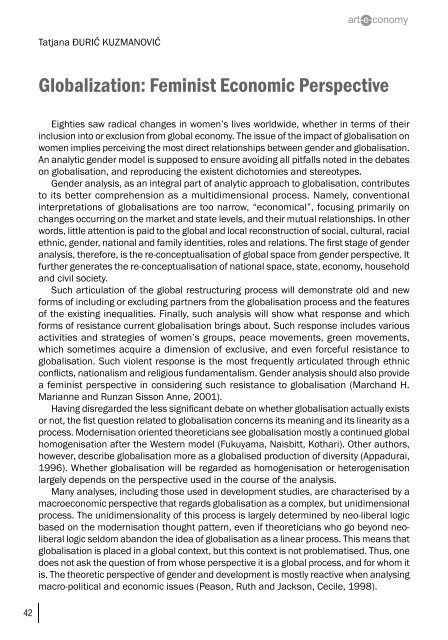art-e-conomy _ reader - marko stamenkovic
art-e-conomy _ reader - marko stamenkovic
art-e-conomy _ reader - marko stamenkovic
Create successful ePaper yourself
Turn your PDF publications into a flip-book with our unique Google optimized e-Paper software.
42<br />
Tatjana ĐURIĆ KUZMANOVIĆ<br />
Globalization: Feminist Economic Perspective<br />
Eighties saw radical changes in women’s lives worldwide, whether in terms of their<br />
inclusion into or exclusion from global e<strong>conomy</strong>. The issue of the impact of globalisation on<br />
women implies perceiving the most direct relationships between gender and globalisation.<br />
An analytic gender model is supposed to ensure avoiding all pitfalls noted in the debates<br />
on globalisation, and reproducing the existent dichotomies and stereotypes.<br />
Gender analysis, as an integral p<strong>art</strong> of analytic approach to globalisation, contributes<br />
to its better comprehension as a multidimensional process. Namely, conventional<br />
interpretations of globalisations are too narrow, “economical”, focusing primarily on<br />
changes occurring on the market and state levels, and their mutual relationships. In other<br />
words, little attention is paid to the global and local reconstruction of social, cultural, racial<br />
ethnic, gender, national and family identities, roles and relations. The first stage of gender<br />
analysis, therefore, is the re-conceptualisation of global space from gender perspective. It<br />
further generates the re-conceptualisation of national space, state, e<strong>conomy</strong>, household<br />
and civil society.<br />
Such <strong>art</strong>iculation of the global restructuring process will demonstrate old and new<br />
forms of including or excluding p<strong>art</strong>ners from the globalisation process and the features<br />
of the existing inequalities. Finally, such analysis will show what response and which<br />
forms of resistance current globalisation brings about. Such response includes various<br />
activities and strategies of women’s groups, peace movements, green movements,<br />
which sometimes acquire a dimension of exclusive, and even forceful resistance to<br />
globalisation. Such violent response is the most frequently <strong>art</strong>iculated through ethnic<br />
conflicts, nationalism and religious fundamentalism. Gender analysis should also provide<br />
a feminist perspective in considering such resistance to globalisation (Marchand H.<br />
Marianne and Runzan Sisson Anne, 2001).<br />
Having disregarded the less significant debate on whether globalisation actually exists<br />
or not, the fist question related to globalisation concerns its meaning and its linearity as a<br />
process. Modernisation oriented theoreticians see globalisation mostly a continued global<br />
homogenisation after the Western model (Fukuyama, Naisbitt, Kothari). Other authors,<br />
however, describe globalisation more as a globalised production of diversity (Appadurai,<br />
1996). Whether globalisation will be regarded as homogenisation or heterogenisation<br />
largely depends on the perspective used in the course of the analysis.<br />
Many analyses, including those used in development studies, are characterised by a<br />
macroeconomic perspective that regards globalisation as a complex, but unidimensional<br />
process. The unidimensionality of this process is largely determined by neo-liberal logic<br />
based on the modernisation thought pattern, even if theoreticians who go beyond neoliberal<br />
logic seldom abandon the idea of globalisation as a linear process. This means that<br />
globalisation is placed in a global context, but this context is not problematised. Thus, one<br />
does not ask the question of from whose perspective it is a global process, and for whom it<br />
is. The theoretic perspective of gender and development is mostly reactive when analysing<br />
macro-political and economic issues (Peason, Ruth and Jackson, Cecile, 1998).


